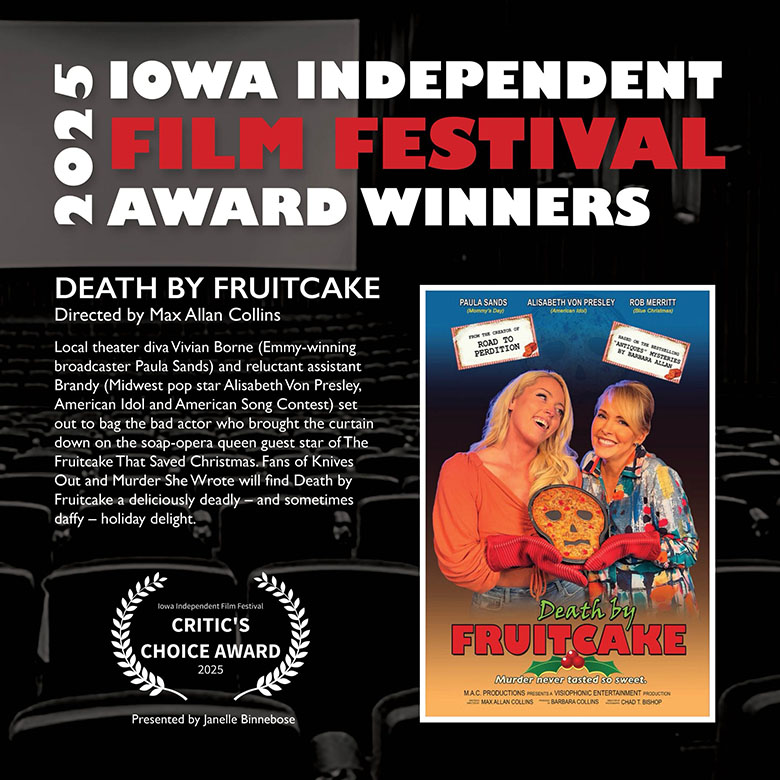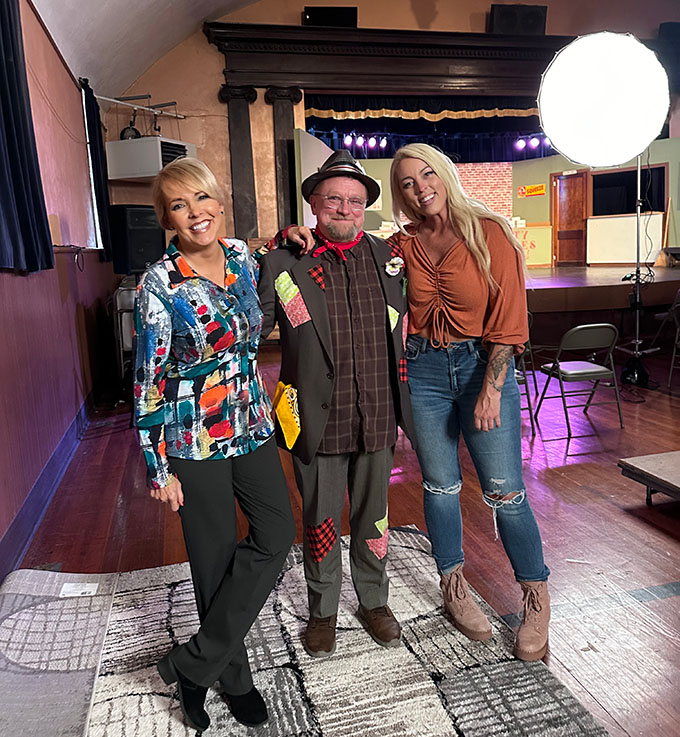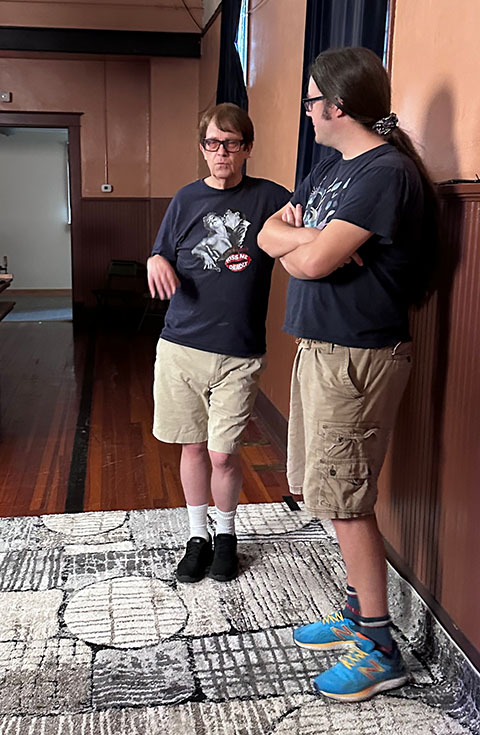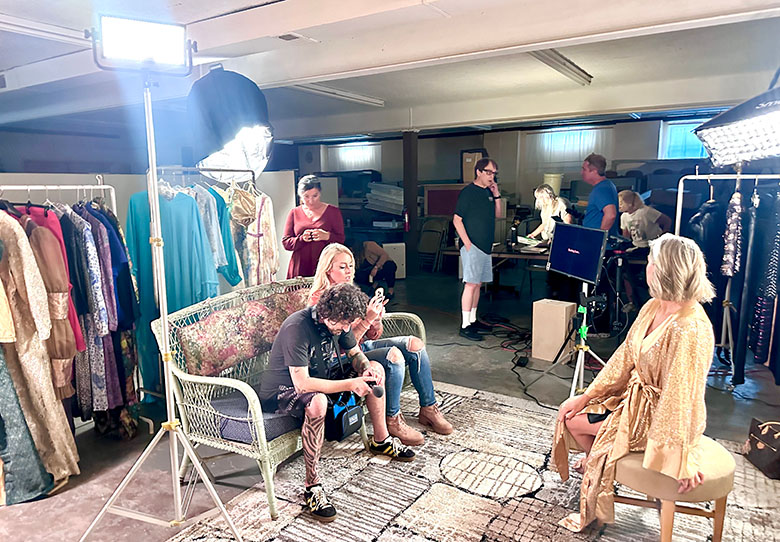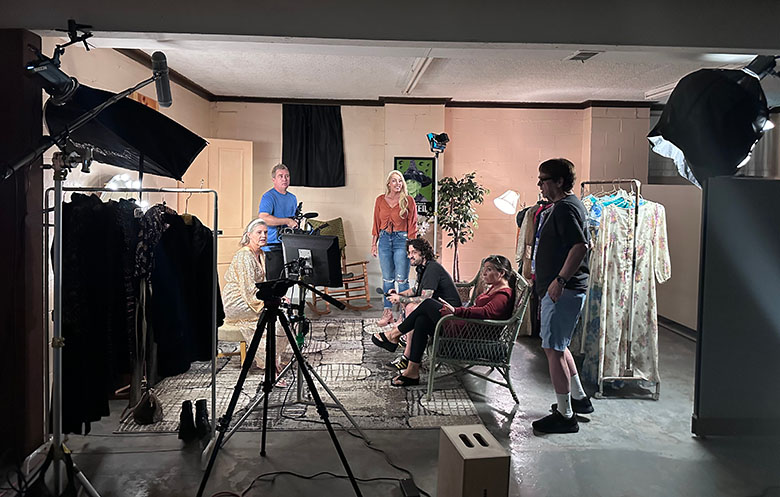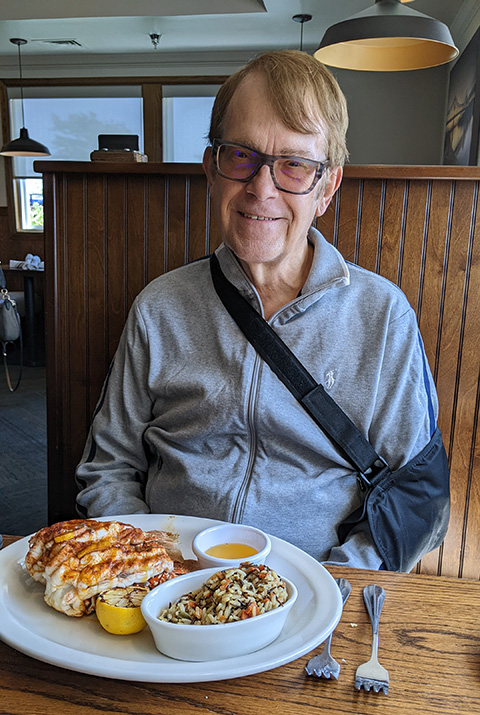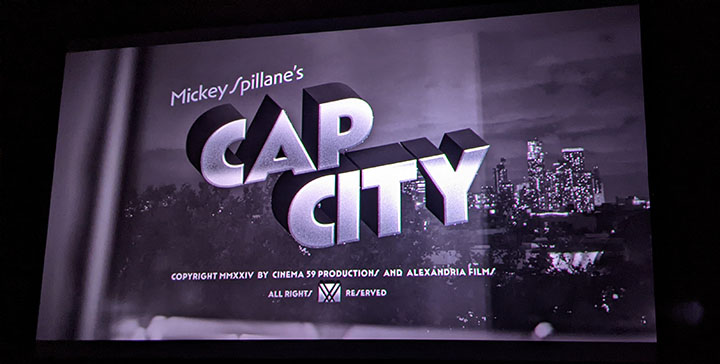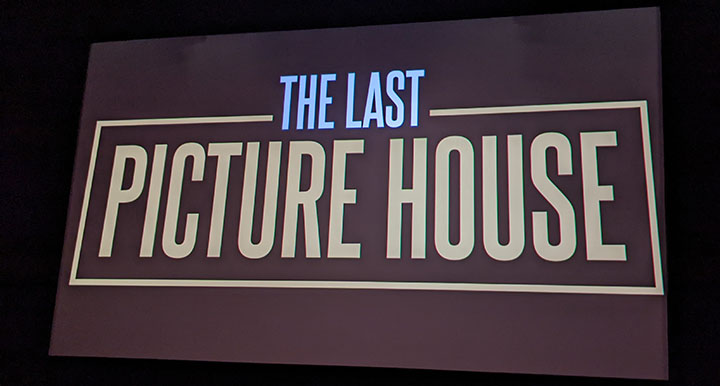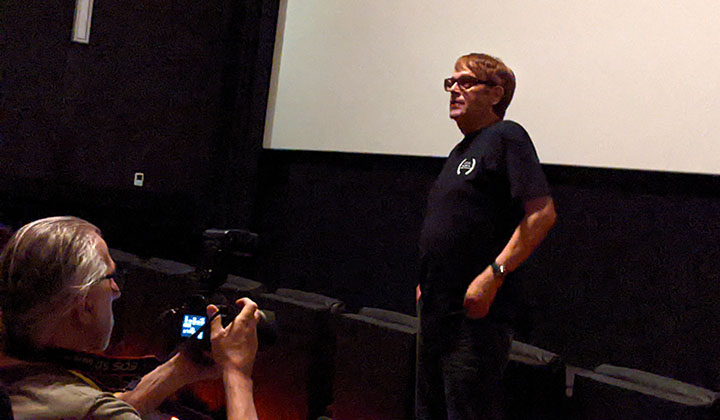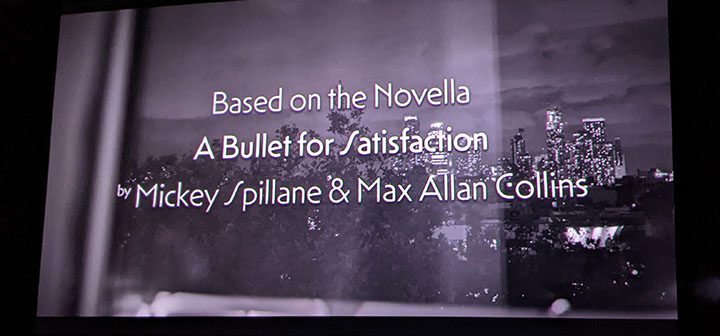Our unusually busy summer – San Diego Comic Con, Star City Film Festival at Waukon, Iowa, and the screening of Cap City at the Last Picture House in Davenport – had us scheduling a needed hospital visit until after all of that was over. I was going in for an ablation to deal with my atrial fibrillation; I’d had this procedure before, a couple of years ago, and it hadn’t taken, i.e., my a-fib had returned.
While I’ve had a number of cardioversions – where they jump-start you like an old Buick – these had proved short-term fixes. They’re also fairly routine, while an ablation is a more serious prospect. Still, ablation is generally an out-patient procedure.
With Barb at the wheel, we set out from Muscatine around 7:30 a.m. on Monday, August 18, for the Rock Island Trinity Heart Center, where I’d had my open-heart surgery back in 2016. I was feeling quite comfortable about returning there, although the radio gave us a hit parade of songs with the word “heart” in them (“Don’t Go Breakin’ My Heart”) or were otherwise ironically off-putting (“I’m Gonna Live Till I Die!”).
We arrived at 9 a.m., knowing we’d likely have a long wait – the ablation was scheduled for 12:45 p.m. – and the preliminaries were fairly typical, although the nurses had trouble getting the necessary two I.V.’s going, and by the time they did, both my arms were in pin-cushion mode. By 5 p.m. I was awake and normal in a recovery room, but my incision was still bleeding, which meant I’d be kept in overnight for observation.
Around 6 p.m. I was moved to the adjacent, older Trinity Rock Island Hospital, to a room Barb recalls was small and less than ideal. Here is where our memories begin to differ. I thought I was in a fairly spacious hotel or motel room. I recall several nurses being introduced to me and assuring me I was in good hands. One was a male nurse, a friendly young man named Joe, who would look in on me periodically.
At some point during the night, probably around midnight, Joe informed me that I needed a procedure involving a catheter, because I hadn’t yet passed urine. I wanted nothing to do with that, and wanted to wait till the next day to talk to my heart doctor about the prospect. Joe was insistent – though always kind and compassionate – that I was in danger if I didn’t have this procedure more or less immediately.
I refused to cooperate until Joe had spoken with Barb on the phone. (She had headed back to Muscatine around 8 p.m. thinking all was well.) Barb told me to go through with the procedure and I reluctantly said yes to it. What followed was more painful than I could ever have imagined, but Joe was professional and gentle, considering.
I spoke with Barb around 2 a.m. and reported that I felt fine; in fact, very good. She was relieved and told me she’d see me in a few hours. But when she arrived at around 7 a.m., she found me agitated and confused, thinking the hospital room was my office – I remember none of this.
A noon release was already scheduled for me and Barb expedited that, thinking I’d do better at home in my normal surroundings.
But back home my condition grew worse. I was confused and behaving oddly, erratically – I cupped my hand under a faucet but didn’t turn the water on, then raised my dry cupped hand to my mouth and “drank” twice; when I went into the bathroom to shave, my electric razor was still packed away and I instead covered half of my face with soap and went dripping to Barb for approval of my efforts. None of this do I remember.
Nate’s wife Abby came over to observe my weird behavior and soon was on the phone with her brother, a nurse in Chicago, who said I should be taken to the ER immediately – I might have had a stroke.
By six p.m. I was at the Muscatine ER, taken there by Barb and Nate; I was immediately given a CAT scan (this I vaguely remember) and given blood tests. While the CAT scan looked okay, the blood work indicated I had a urinary tract infection (UTI) and walking pneumonia. An antibiotic was administered through my I.V. All of this took about six hours, during which time my family suffered far more than I did.
The ER doctor said I needed to go back to Rock Island Trinity to get an MRI because Muscatine did not have the necessary machine. To jump the queue, I needed to arrive by ambulance. This took a while to arrange, and to secure a room for me back at Trinity.
Here is where my memory, in its very unreliable state, kicks in. I am strapped to a gurney and loaded into the ambulance. In the darkness beyond, which I could view through the open rear ambulance doors, I saw a huge neighborhood enveloped in that darkness, lights on porches and elsewhere here and there like a thousand fireflies. I could see Barb and Nate and others on the steps in front of our house, as if it were a tall building and they were up several flights, watching me go.
The ambulance ride went on forever. I sensed the EMTs seated on either side of me, but mostly it was flashing lights and highway and rough ride. Barb was not with me (she had stayed behind to catch a few hours of sleep after the ordeal).
Next thing I knew I was being shown into a bizarre hotel room by a surly, eye-rolling masked female nurse. I complained bitterly – where was the bed? There was no bed! The eye-rolling, disgusted nurse gestured to her right and there indeed was a small cot in front of a curtained closet. I threw the curtain back and a strange bathroom awaited: two toilet bowls back to back; no shower or tub or sink.
The rest of this hotel room was no better and no less weird. Nowhere for clothes or possessions other than a long shelf under a big window. The TV was up high on the far wall and a chalkboard or something took up much of the rest of that wall.
I demanded to speak to the management. I was ignored. I demanded to be allowed to call Barb. That too was ignored. Finally I was agitated enough for someone in responsibility to be summoned. A management group appeared on the other side of a window and at first refused my request to use the phone. Finally they relented, but I had difficulty dialing on the phone they provided. I may have gotten through to Barb, finally, at which time I may have said, “This is the worst hotel room you ever booked for us!”
Now I began to demand to speak to the top person at this hotel, whoever that was. I was told a request for that had been put in, and the top person would be around to see me. I paced, waiting for that person to show up. A TV monitor was rolled in on the other side of the glass and on the screen a pleasant middle-aged woman did her best to calm me down. She announced she could not come to see me because she was in Nashville at a business conference.
I was furious. I’d been told I’d have a personal visit from the top executive at this hotel or whatever it was. I was starting feel like a prisoner.
I may have slept for a while. My next memory is being in a different room, a darkened room with wood-paneled walls, and several big windows onto the outer area, windows that were covered in narrow blinds. I now was being watched – held prisoner by – a nurse, but one who was not surly and was quite nice. I played up to her. Made friends.
A party was going on in the room beyond the blinds. Somehow I knew a murderer was present at the party and I wanted to expose him. But the nice nurse would not let me leave the room. I began to look between the blades of the blinds to see what was happening. It was a Christmas party, down at the far end of the room. I shouted to them but no one heard.
A man and woman, in Christmas attire, were making out by a pillar at the nearer end of the room; they didn’t respond to my cries either. Other partygoers were coming from around the corner and walking down to the party, all in festive garb. I became increasingly frustrated because some of the partygoers had moved closer to me, and were right on the other side of the glass, but still couldn’t hear me. I begged my nice nurse/jailer, watching me from a chair, to let me join the party – finally she let me lean out of the door, but it didn’t do any good. Nobody acknowledged me.
After a time the party wound down and partygoers, down at the other end of the room, departed. Someone, I’m not sure who, told me (as I remember) that the murderer had been identified and I was supposed to keep him busy. Back in the hotel room, I met the murderer, a pleasant blocky man – the janitor at the facility, I understood – who wore a medical mask.
I asked him, “Are you here to kill me?”
He did not respond. He was silently watching me, and I went into a clever speech in which I told him I was worth more to him alive. I wrote mystery novels and knew all sorts of ways to help him in his criminal pursuits. We should throw in together! He stood at the window looking out wordlessly. Finally he nodded.
Success!
At some point I came to understand that a hit team had been hired to assassinate this dangerous individual. They would show up sometime today in a harmless guise – a medical team, room cleaning staff, food delivery, etc. – and take him out. I was not told when or by whom, to make sure I didn’t give this effort away.
Barb arrived around 6 a.m. on Wednesday after my long manic night. She found a medical security man named Dana waiting (my partner-in-crime “murderer”) and found me confused, agitated, my speech disjointed and words slurring. I have no memory of this.
Around 10 a.m. I was taken for an MRI, with Barb along to assist with me as needed. The MRI revealed a possible small stroke, but not when it happened – likely was years before; the neurologist was not concerned and felt my confused state was due to the urinary tract infection.
My next memory is a tall, medically-masked apparent doctor who was giving me eye signals about the need for me to keep a watchful eye on the murderer I was tasked to contain. I thought this “doctor” might really be the in-disguise tall waiter who made us sundaes back in Davenport at Lagomarcino’s.
Barb and the minder chatted and talked, and I occasionally joined in. It was all very friendly now and I was utterly unaware of how disjointed my conversation was and how unintelligible my words often were.
At some point I took Barb aside and said I thought we should call the assassin team off – Dana was just too nice. She assured me she’d already taken care of that.
Later I found myself sitting in the front row of a theater with Barb seated behind me and one seat over. I was asked to answer some questions, for what reason I did not know. The woman interrogating was polite but patronizing, and her associate was a young woman who kept jumping up and down as if she had to go to the bathroom.
The patronizing woman would ask and I would answer, growing increasingly defensive. Barb took the woman into the hall and told her that the outrageous claims I was making – writing Dick Tracy, having a Tom Hanks movie made from one of my books – were all real. That everything I was saying was real, just coming out in jumbled order.
The woman (a speech therapist, I have since learned) handed me a sheet of paper and asked me read the sentences printed there. The first thing I did (because I now knew this was a “gotcha” situation) was point out grammatical errors in the sentences she provided. This seemed to startle her.
Later, I overheard Barb talking with Dana about her apparent plans to fly to Japan (actually, they were discussing a Japanese manga she was reading). I immediately felt she was about to abandon me. She was resting in a reclining chair while I was in the adjacent (hospital) bed. I sent a loving look her way. Nothing. I sent a scowl her way. Nothing.
I sat up and scrambled closer to her and pointed at her and said, “We need to talk – alone!”
Now, unbeknownst to me, Dana was not allowed to leave. I needed constant supervision. But Barb convinced him to step into the hall, where he watched through the cracked door.
Barb loomed over me and got her face right into mine. “I’m your wife of fifty-seven years and I love you. I would never hurt you.” My memory right now is filled with her wonderful face, tensed though it was with frustration and fear.
“You’re not going to Japan?” I asked.
“No. And we are not in a hotel room. We are in Rock Island at the hospital.”
I asked, “How can I trust you?”
She said, “Through shared experiences.”
She proceeded, with Perry Mason-like skill, to ask me questions. Did I remember going to San Diego and the comic con? The horrible hotel room at the Marriott? Yes. Did I remember driving to Waukon for the film festival? And getting stranded there? Yes. Do you really think I’m going to leave you here and fly to Japan? …No.
This cross-examination went on for some time, as she used my own logic to return me to something approaching sanity. I became more coherent. If I offered up a rush of words, unintelligibly fast, she would ask me to repeat what I’d said but slowly, a word at a time. Then the words would be clear. I began to see my surroundings as they were – for example a grotesque robot was merely a medical monitor on a stand, its haunting face – the creature from Alien affixed with a wide oval mouth – a soap dispenser.
When Dana was replaced by a young high school girl, Barb – though way overdue for a break – stayed with me through the night. I was much better, but…
…I now thought I was in a half-way house, in a much larger room with a kitchen beyond. Sometimes it was in Muscatine, at the Art Museum, other times in a sunken living room in Hollywood, where two imaginary actresses were hoping to get some roles to help pay for these nice new surroundings.
Somehow by Thursday morning I was aware I was in a hospital room. My appetite had returned and my trips to the bathroom were steadier. Various doctors visited and were pleased with my recovery. I was released from the hospital and Barb took me home.
Back in Muscatine, Nate and Abby – and our two grandkids, Sam and Lucy – brought us dinner. I was a little rocky, but so glad to be home.
Am I fully recovered? I would say so. But to me the oddest thing is that all of my memories – even now that I know what had really gone on – are rooted in the false locations that my mind conjured up.
Well, what would you expect from the creator of Quarry?
M.A.C.
